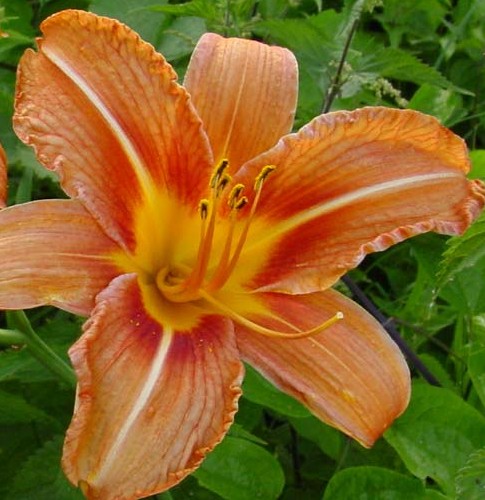 Daylily (Hemerocalis fulva) is also known by several other names including ditch lily, outhouse lily, and twany lily. It is native to Asia but was introduced into North America in the late 19th century and has become wide spread there, often becoming invasive. It is unrelated to ture lilies (Lilum spp.) although its flowers resembles that of a true lily. True lilies have short leaves all the way up the stem to the flowers, while daylilies bear their flowers on leafless stems that are emerge froma tuft of leaves. The flowers of the daylily last only a single day, hence the common name. Other common names reflect the location where they were planted and their color. The generic name, Hemerocalis, comes from the Greek hemera meaning day, and kalles meaning beauty.
Daylily (Hemerocalis fulva) is also known by several other names including ditch lily, outhouse lily, and twany lily. It is native to Asia but was introduced into North America in the late 19th century and has become wide spread there, often becoming invasive. It is unrelated to ture lilies (Lilum spp.) although its flowers resembles that of a true lily. True lilies have short leaves all the way up the stem to the flowers, while daylilies bear their flowers on leafless stems that are emerge froma tuft of leaves. The flowers of the daylily last only a single day, hence the common name. Other common names reflect the location where they were planted and their color. The generic name, Hemerocalis, comes from the Greek hemera meaning day, and kalles meaning beauty.
All parts of the plant are edible including the young leaves, tubers, buds, and flowers. The green buds have a mild aspagu taste and can be roasted, steamed, boiled, stir-fried or pickled. Boiled or steamed buds are delicious with butter, salt and pepper. They are common in Chinese, Thai, Korean, Japanese, and Vietnamese cooking where they are known as golden needles.
The petals have a sweet lettuce sort of taste and are especilly good in salads where they add flavor, texture, and color. They can also be added to egg dishes, soups, and baked goods including biscuits and cheesecake Whole flowers,half or fully open, even day old, can be dipped in batter and fried for a tempura-style dish.
Daylily buds can be harvested and saved in the refrigerator for several days but the flowers are best used the same day as they are picked. Wash the buds and flowers carefully and lay them on a towel to dry. Six flowers will provide about one cup of petals.